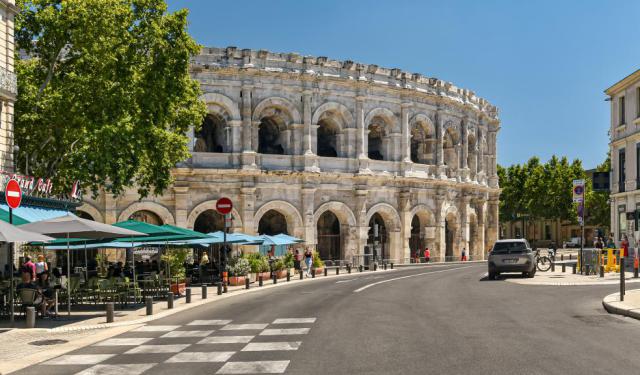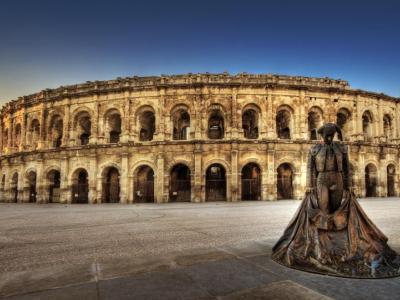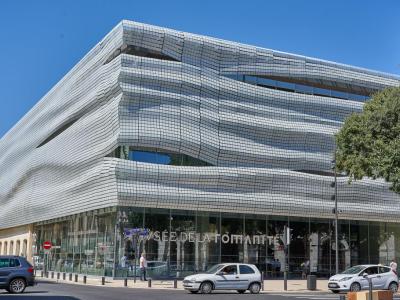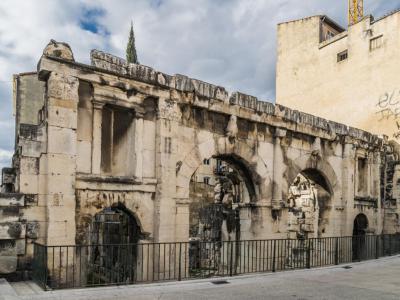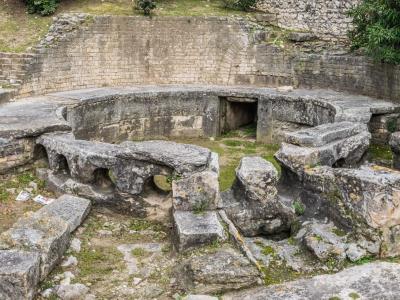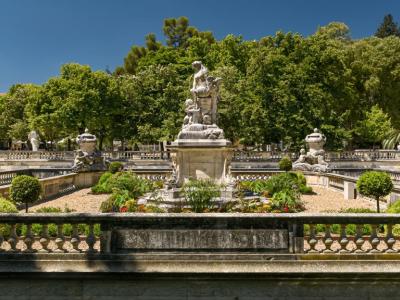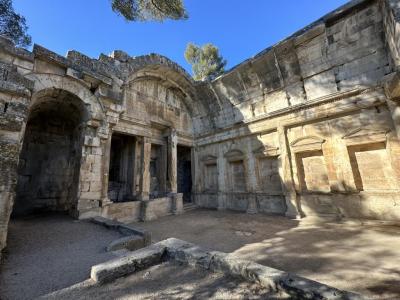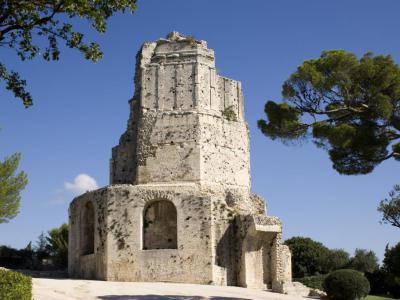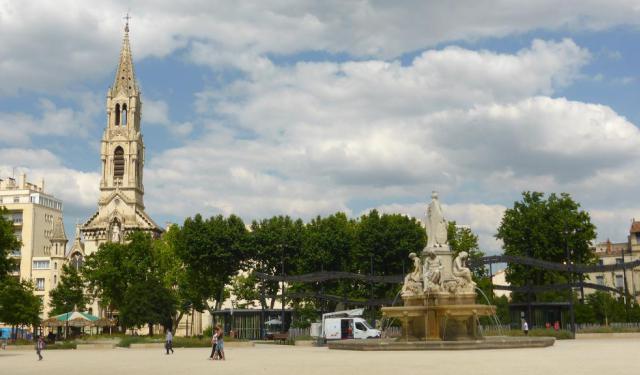Ancient Roman Ruins in Nimes (Self Guided), Nimes
Nicknamed “the French Rome,” the southern French town of Nimes is indeed the most Roman city outside of Italy. In large part, this is due to a wealth of architectural monuments that have remained here since the Roman era. Some ruined and some well-preserved, they offer a captivating glimpse into the ancient history stretching back to the early days of Roman expansion.
A true testament to the grandeur of Roman architecture is the Arena of Nimes (Arenes de Nîmes). This colossal amphitheater, constructed in the 1st century AD, once hosted gladiator contests and chariot races, drawing crowds from near and far.
The Museum of Romanity of Nîmes is a treasure trove of Roman artifacts and history. It houses an extensive collection of sculptures, mosaics, and everyday objects, providing visitors with an immersive experience of life in ancient Nimes.
The majestic Augustus Gate (Porte d'Auguste), or rather what's left of it, is the remains of the gateway that once welcomed travelers into the city during Roman times.
In contrast to it, the so-called Square House (Maison Carrée) is a remarkably well-preserved Roman temple dedicated to Emperor Augustus. Its graceful Corinthian columns and intricate detailing showcase the architectural prowess of the era.
The Castellum Aquae, formerly a vital water distribution hub in ancient Nimes, reflects the Romans' advanced engineering skills.
Fountain Gardens (Jardins de la Fontaine) is a serene park that encompasses the Temple of Diana. This temple, surrounded by lush greenery and water features, provides a tranquil escape into Roman-era landscaping.
Crowning the Fountain Gardens, the Magne Tower (Tour Magne) once offered panoramic views of the city. This ancient watchtower served both as a defensive structure and a symbol of Roman power.
Collectively, these remnants of the past allow you to envision the grandeur and sophistication of ancient Rome. As you plan to explore Nimes, take time to acquaint yourself with the local Roman treasures more closely so as to appreciate the history and culture of this beautiful city.
A true testament to the grandeur of Roman architecture is the Arena of Nimes (Arenes de Nîmes). This colossal amphitheater, constructed in the 1st century AD, once hosted gladiator contests and chariot races, drawing crowds from near and far.
The Museum of Romanity of Nîmes is a treasure trove of Roman artifacts and history. It houses an extensive collection of sculptures, mosaics, and everyday objects, providing visitors with an immersive experience of life in ancient Nimes.
The majestic Augustus Gate (Porte d'Auguste), or rather what's left of it, is the remains of the gateway that once welcomed travelers into the city during Roman times.
In contrast to it, the so-called Square House (Maison Carrée) is a remarkably well-preserved Roman temple dedicated to Emperor Augustus. Its graceful Corinthian columns and intricate detailing showcase the architectural prowess of the era.
The Castellum Aquae, formerly a vital water distribution hub in ancient Nimes, reflects the Romans' advanced engineering skills.
Fountain Gardens (Jardins de la Fontaine) is a serene park that encompasses the Temple of Diana. This temple, surrounded by lush greenery and water features, provides a tranquil escape into Roman-era landscaping.
Crowning the Fountain Gardens, the Magne Tower (Tour Magne) once offered panoramic views of the city. This ancient watchtower served both as a defensive structure and a symbol of Roman power.
Collectively, these remnants of the past allow you to envision the grandeur and sophistication of ancient Rome. As you plan to explore Nimes, take time to acquaint yourself with the local Roman treasures more closely so as to appreciate the history and culture of this beautiful city.
How it works: Download the app "GPSmyCity: Walks in 1K+ Cities" from Apple App Store or Google Play Store to your mobile phone or tablet. The app turns your mobile device into a personal tour guide and its built-in GPS navigation functions guide you from one tour stop to next. The app works offline, so no data plan is needed when traveling abroad.
Ancient Roman Ruins in Nimes Map
Guide Name: Ancient Roman Ruins in Nimes
Guide Location: France » Nimes (See other walking tours in Nimes)
Guide Type: Self-guided Walking Tour (Sightseeing)
# of Attractions: 8
Tour Duration: 2 Hour(s)
Travel Distance: 3.7 Km or 2.3 Miles
Author: DanaOffice
Sight(s) Featured in This Guide:
Guide Location: France » Nimes (See other walking tours in Nimes)
Guide Type: Self-guided Walking Tour (Sightseeing)
# of Attractions: 8
Tour Duration: 2 Hour(s)
Travel Distance: 3.7 Km or 2.3 Miles
Author: DanaOffice
Sight(s) Featured in This Guide:
- Arenes de Nimes (Arena of Nîmes)
- Musee de la Romanite (Museum of Roman Civilization)
- Porte d'Auguste (Augustus Gate)
- Maison Carree (Square House)
- Castellum Aquae (Water Castle)
- Jardins de la Fontaine (Fountain Gardens)
- Temple de Diane (Temple of Diana)
- Tour Magne (Magne Tower)
1) Arenes de Nimes (Arena of Nîmes) (must see)
The Arena of Nîmes is a magnificent Roman amphitheatre. Erected around 100 CE, shortly after the renowned Colosseum of Rome, this arena stands as one of the world's most exceptionally preserved Roman amphitheatres. With its remarkable dimensions, the Arena of Nîmes measures 133 meters (436 feet) in length and 101 meters (331 feet) in width, featuring an arena that spans 68 by 38 meters (223 by 125 feet). Its grand outer facade soars to a height of 21 meters (69 feet) and boasts two storeys adorned with 60 arcades. Among the 400 Roman amphitheatres known to exist, it ranks among the 20 largest.
In ancient times, this grand structure had the capacity to accommodate a crowd of 24,000 spectators, who were accommodated across 34 tiers of terraces divided into four self-contained zones or maeniana. The arena served a dual purpose, functioning as a venue for public events and theatrical performances while also hosting gladiator battles that captivated the masses.
Presently, the Arena of Nîmes continues to play a central role in the city's cultural life. It hosts two annual bullfights as part of the Feria de Nîmes, attracting enthusiasts and spectators alike. Additionally, the arena serves as a captivating backdrop for various public events, including reenactments of antiquity such as "The Great Roman Games" and concerts. At its entrance, the statue of Christian Montcouquiol, known as Nimeño II, stands proudly, earning it the name "Hero."
Notably, in 1853, an unfortunate incident occurred at the arena when balloonist M. Louis Deschamps tragically lost his life during his 120th flight. Despite adverse weather conditions that had prompted the mayor to cancel a planned parachute performance, the balloon took off as scheduled and encountered the inclement weather. Deschamps was ejected from the basket, and the balloon came down approximately half a mile away from the arena. This incident remains a somber part of the arena's history.
In ancient times, this grand structure had the capacity to accommodate a crowd of 24,000 spectators, who were accommodated across 34 tiers of terraces divided into four self-contained zones or maeniana. The arena served a dual purpose, functioning as a venue for public events and theatrical performances while also hosting gladiator battles that captivated the masses.
Presently, the Arena of Nîmes continues to play a central role in the city's cultural life. It hosts two annual bullfights as part of the Feria de Nîmes, attracting enthusiasts and spectators alike. Additionally, the arena serves as a captivating backdrop for various public events, including reenactments of antiquity such as "The Great Roman Games" and concerts. At its entrance, the statue of Christian Montcouquiol, known as Nimeño II, stands proudly, earning it the name "Hero."
Notably, in 1853, an unfortunate incident occurred at the arena when balloonist M. Louis Deschamps tragically lost his life during his 120th flight. Despite adverse weather conditions that had prompted the mayor to cancel a planned parachute performance, the balloon took off as scheduled and encountered the inclement weather. Deschamps was ejected from the basket, and the balloon came down approximately half a mile away from the arena. This incident remains a somber part of the arena's history.
2) Musee de la Romanite (Museum of Roman Civilization) (must see)
Opened in 2018 the Museum of Romanity breathes new life into the former Museum of Archaeology, previously situated at the historic Jesuits' College on the Boulevard Amiral-Courbet.
The museum's inception was driven by a series of remarkable archaeological discoveries made between 2006 and 2007 at the Allées Jaurès in Nîmes. These discoveries included a domus, or Roman house, and two extraordinary mosaics featuring scenes of Achilles and Pentheus. Notably, experts in the field of archaeology have drawn parallels between these findings and those uncovered in the renowned ancient city of Pompeii.
The Museum of Romanity seamlessly melds the original archaeology collection with these more recent and exceptional archaeological revelations. Housed within an ultra-modern building, which intriguingly resembles a "folded glass toga," the museum is strategically situated along the historic site of the old Roman ramparts, directly facing the iconic 2,000-year-old Arènes de Nîmes.
The exhibits span a wide temporal spectrum, encompassing items from the prehistoric Iron Age to Gallo-Roman relics such as ceramics, bronze tableware, lamps, toiletry articles, and clothing accessories.
Among the museum's standout attractions are its impressive Roman coin collection and meticulously detailed mosaics that vividly transport visitors back in time, offering glimpses into the everyday life of this bygone era.
Stepping outside, the museum's archaeological garden invites exploration, offering insights into the city's multifaceted ancient heritage. Landscaped with lush Mediterranean flora, this garden features three distinct levels, each representing a different historical period: pre-Roman, classical Roman, and post-Roman eras.
Designed with tourists in mind, the museum boasts a rooftop terrace that offers breathtaking panoramic views of the city. Additionally, visitors can explore a well-stocked bookstore and gift shop. For dining options, the Musée de la Romanité caters to various tastes. The Café du Musée, a casual eatery with entrance at 16 Boulevard des Arènes, serves breakfast, lunch, snacks, and evening meals daily, with sunny patio seating.
The museum's inception was driven by a series of remarkable archaeological discoveries made between 2006 and 2007 at the Allées Jaurès in Nîmes. These discoveries included a domus, or Roman house, and two extraordinary mosaics featuring scenes of Achilles and Pentheus. Notably, experts in the field of archaeology have drawn parallels between these findings and those uncovered in the renowned ancient city of Pompeii.
The Museum of Romanity seamlessly melds the original archaeology collection with these more recent and exceptional archaeological revelations. Housed within an ultra-modern building, which intriguingly resembles a "folded glass toga," the museum is strategically situated along the historic site of the old Roman ramparts, directly facing the iconic 2,000-year-old Arènes de Nîmes.
The exhibits span a wide temporal spectrum, encompassing items from the prehistoric Iron Age to Gallo-Roman relics such as ceramics, bronze tableware, lamps, toiletry articles, and clothing accessories.
Among the museum's standout attractions are its impressive Roman coin collection and meticulously detailed mosaics that vividly transport visitors back in time, offering glimpses into the everyday life of this bygone era.
Stepping outside, the museum's archaeological garden invites exploration, offering insights into the city's multifaceted ancient heritage. Landscaped with lush Mediterranean flora, this garden features three distinct levels, each representing a different historical period: pre-Roman, classical Roman, and post-Roman eras.
Designed with tourists in mind, the museum boasts a rooftop terrace that offers breathtaking panoramic views of the city. Additionally, visitors can explore a well-stocked bookstore and gift shop. For dining options, the Musée de la Romanité caters to various tastes. The Café du Musée, a casual eatery with entrance at 16 Boulevard des Arènes, serves breakfast, lunch, snacks, and evening meals daily, with sunny patio seating.
3) Porte d'Auguste (Augustus Gate)
The Augustus Gate, referred to as "Porte d'Arles," it was a crucial component of the extensive Roman wall that surrounded the city of Nîmes and served as one of the primary entrances to the city. It also marked the entry point of the Domitian Way into the colony. The remains of this ancient gate are a testament to its historical significance.
The Augustus Gate holds the status of a historic monument, a designation it received in 1840. This gate boasts four semicircular arch passages, consisting of two large central ones for vehicular traffic and two smaller lateral passages designed for pedestrians. In its original form, the gate was flanked by two semicircular towers. The location of these towers is still evident today, marked by circles made of large flat stones on the sidewalk.
The Augustus Gate derived its name from Emperor Augustus, who played a pivotal role in fortifying the town. This ancient entrance gate was part of the Via Domitia, the old Roman road that led to Rome. Today, it is located at the intersection of Boulevard Gambetta and Boulevard Amiral Courbet.
The gate's origins can be traced back to the 1st century BCE, as indicated by an inscription. Over time, it became incorporated into the walls of a medieval fortress. Interestingly, the gate was concealed until 1752 when the fortress was partially damaged, revealing this significant historical artifact. Near the gate, a modern copy of a statue of Augustus is on display, serving as a reminder of the gate's association with the Roman emperor and its historical importance in the city of Nîmes.
The Augustus Gate holds the status of a historic monument, a designation it received in 1840. This gate boasts four semicircular arch passages, consisting of two large central ones for vehicular traffic and two smaller lateral passages designed for pedestrians. In its original form, the gate was flanked by two semicircular towers. The location of these towers is still evident today, marked by circles made of large flat stones on the sidewalk.
The Augustus Gate derived its name from Emperor Augustus, who played a pivotal role in fortifying the town. This ancient entrance gate was part of the Via Domitia, the old Roman road that led to Rome. Today, it is located at the intersection of Boulevard Gambetta and Boulevard Amiral Courbet.
The gate's origins can be traced back to the 1st century BCE, as indicated by an inscription. Over time, it became incorporated into the walls of a medieval fortress. Interestingly, the gate was concealed until 1752 when the fortress was partially damaged, revealing this significant historical artifact. Near the gate, a modern copy of a statue of Augustus is on display, serving as a reminder of the gate's association with the Roman emperor and its historical importance in the city of Nîmes.
4) Maison Carree (Square House) (must see)
The Square House stands as a remarkable testament to Roman architecture and religious devotion in the charming city of Nîmes. This ancient Roman temple is celebrated as one of the best-preserved examples of Roman temples within the former Roman Empire's territory. It served as a mid-sized Augustan provincial temple dedicated to the Imperial cult, specifically as a caesareum.
The Maison Carrée has had a profound influence on architecture throughout history. It inspired the design of neoclassical structures such as the Église de la Madeleine in Paris, the St. Marcellinus Church in Rogalin, Poland, and, notably, the Virginia State Capitol in the United States. The Virginia State Capitol's design was the work of Thomas Jefferson, who, during his time as the Minister to France in 1785, had a stucco model of the Maison Carrée created. This temple's enduring impact extends across continents and centuries.
In recognition of its cultural significance and architectural splendor, the Maison Carrée was inscribed on the UNESCO World Heritage List in September 2023. Its historical origins date back to around 4–7 AD, when the temple was dedicated or rededicated to Gaius and Lucius Caesar, the grandsons and adopted heirs of Augustus, both of whom met untimely demises. Over the centuries, the original dedication inscription to Gaius and Lucius was lost, but in 1758, a local scholar, Jean-François Séguier, meticulously reconstructed the inscription based on the arrangement and number of holes on the front frieze and architrave, which had once held bronze letters.
The Maison Carrée embodies elements of a Tuscan-style Roman temple as described by Vitruvius, a Roman writer on architecture from the same era, albeit with the use of the Corinthian order. Elevated on a substantial podium, standing 2.85 meters high, the temple exhibits dimensions of 26.42 meters in length and 13.54 meters in width, creating a rectangular structure that is nearly twice as long as it is wide. Its imposing façade features a deep portico or pronaos that extends almost one-third of the building's total length, lavishly adorned with ornate columns and capitals. The presence of this extensive porch distinctly highlights the temple's frontal aspect, setting it apart from the designs of ancient Greek temples.
Upon entering through a grand door measuring 6.87 meters in height and 3.27 meters in width, visitors encounter the small, windowless interior, which originally housed the temple's shrine. Today, this space is used to host a film presentation that offers insights into Nîmes' rich Roman history. Although no ancient decorations remain within the cella, the Maison Carrée's architectural and historical significance continues to captivate visitors from around the world.
The Maison Carrée has had a profound influence on architecture throughout history. It inspired the design of neoclassical structures such as the Église de la Madeleine in Paris, the St. Marcellinus Church in Rogalin, Poland, and, notably, the Virginia State Capitol in the United States. The Virginia State Capitol's design was the work of Thomas Jefferson, who, during his time as the Minister to France in 1785, had a stucco model of the Maison Carrée created. This temple's enduring impact extends across continents and centuries.
In recognition of its cultural significance and architectural splendor, the Maison Carrée was inscribed on the UNESCO World Heritage List in September 2023. Its historical origins date back to around 4–7 AD, when the temple was dedicated or rededicated to Gaius and Lucius Caesar, the grandsons and adopted heirs of Augustus, both of whom met untimely demises. Over the centuries, the original dedication inscription to Gaius and Lucius was lost, but in 1758, a local scholar, Jean-François Séguier, meticulously reconstructed the inscription based on the arrangement and number of holes on the front frieze and architrave, which had once held bronze letters.
The Maison Carrée embodies elements of a Tuscan-style Roman temple as described by Vitruvius, a Roman writer on architecture from the same era, albeit with the use of the Corinthian order. Elevated on a substantial podium, standing 2.85 meters high, the temple exhibits dimensions of 26.42 meters in length and 13.54 meters in width, creating a rectangular structure that is nearly twice as long as it is wide. Its imposing façade features a deep portico or pronaos that extends almost one-third of the building's total length, lavishly adorned with ornate columns and capitals. The presence of this extensive porch distinctly highlights the temple's frontal aspect, setting it apart from the designs of ancient Greek temples.
Upon entering through a grand door measuring 6.87 meters in height and 3.27 meters in width, visitors encounter the small, windowless interior, which originally housed the temple's shrine. Today, this space is used to host a film presentation that offers insights into Nîmes' rich Roman history. Although no ancient decorations remain within the cella, the Maison Carrée's architectural and historical significance continues to captivate visitors from around the world.
5) Castellum Aquae (Water Castle)
Castellum Aquae, also knwon as Castellum divisorium, is an intriguing Roman site that played a vital role in the city's water distribution system during antiquity. This unassuming structure once served as the critical point where the city's water supply, brought in from the aqueducts, was collected and subsequently dispersed throughout Nimes.
Constructed during the middle of the first century AD, Castellum Aquae stood as an engineering marvel of its time, functioning in conjunction with the renowned Pont du Gard aqueduct. The water would embark on an impressive journey of approximately 50 kilometers, traveling over the Pont du Gard, before reaching this distribution hub. The structure features round apertures, through which lead pipes conveyed the water to various fountains and public baths, ensuring that Nimes' inhabitants had access to this precious resource.
At the rear of Castellum Aquae, a sluice gate was employed to control and regulate the flow of water. This level of hydraulic engineering showcased the Romans' mastery of aqueduct systems and their understanding of how to efficiently manage water resources.
However, the significance of Castellum Aquae was largely forgotten over time. During the construction of a citadel in 1688, the structure was filled with rubble and buried. It remained hidden until 1844 when it was excavated, revealing its historical importance and allowing the public to once again appreciate this piece of Roman engineering.
Today, Castellum Aquae stands as a relatively small and unassuming relic of the Roman era, especially when compared to the more extensive and well-known Roman ruins in Nimes. Nevertheless, it serves as a fascinating glimpse into the city's ancient water supply system and the technological achievements of the Romans.
Constructed during the middle of the first century AD, Castellum Aquae stood as an engineering marvel of its time, functioning in conjunction with the renowned Pont du Gard aqueduct. The water would embark on an impressive journey of approximately 50 kilometers, traveling over the Pont du Gard, before reaching this distribution hub. The structure features round apertures, through which lead pipes conveyed the water to various fountains and public baths, ensuring that Nimes' inhabitants had access to this precious resource.
At the rear of Castellum Aquae, a sluice gate was employed to control and regulate the flow of water. This level of hydraulic engineering showcased the Romans' mastery of aqueduct systems and their understanding of how to efficiently manage water resources.
However, the significance of Castellum Aquae was largely forgotten over time. During the construction of a citadel in 1688, the structure was filled with rubble and buried. It remained hidden until 1844 when it was excavated, revealing its historical importance and allowing the public to once again appreciate this piece of Roman engineering.
Today, Castellum Aquae stands as a relatively small and unassuming relic of the Roman era, especially when compared to the more extensive and well-known Roman ruins in Nimes. Nevertheless, it serves as a fascinating glimpse into the city's ancient water supply system and the technological achievements of the Romans.
6) Jardins de la Fontaine (Fountain Gardens) (must see)
The Fountain Gardens is a picturesque public park nestled in the heart of Nîmes. These gardens have a rich history and are closely tied to the city's ancient roots.
Originally, the site was home to a sacred spring venerated by the people long before the Romans arrived. In fact, the source of the Fontaine played a significant role in the founding of the city centuries before the Gallo-Roman era.
The Fountain Gardens is not only one of the earliest public parks in Europe but also one of the most enchanting. As you wander through these gardens adorned with monumental vases and Baroque-style statues, you'll come across various terraces and water features. The layout of the gardens was part of an 18th-century project to enhance the beauty of Nîmes and is framed by the remnants of the ancient city walls.
While exploring the tranquil ponds and meandering waterways, you may stumble upon the captivating ruins of the Roman-era Temple de Diane. Although its exact purpose remains a mystery, it is believed to have been a sanctuary connected to a sacred spring or possibly part of an ancient bathing complex.
Originally, the site was home to a sacred spring venerated by the people long before the Romans arrived. In fact, the source of the Fontaine played a significant role in the founding of the city centuries before the Gallo-Roman era.
The Fountain Gardens is not only one of the earliest public parks in Europe but also one of the most enchanting. As you wander through these gardens adorned with monumental vases and Baroque-style statues, you'll come across various terraces and water features. The layout of the gardens was part of an 18th-century project to enhance the beauty of Nîmes and is framed by the remnants of the ancient city walls.
While exploring the tranquil ponds and meandering waterways, you may stumble upon the captivating ruins of the Roman-era Temple de Diane. Although its exact purpose remains a mystery, it is believed to have been a sanctuary connected to a sacred spring or possibly part of an ancient bathing complex.
7) Temple de Diane (Temple of Diana)
The Temple of Diana, a remarkable 1st-century ancient Roman structure in Nîmes, stands as a testament to the architectural and historical richness of the region. This structure, known as the Temple of Diana, was built during the reign of Augustus and is located near the gushing spring of "La Fontaine." It is closely associated with an Augusteum, a sanctuary dedicated to the veneration of the emperor and his family, with a central focus on a nymphaeum.
Although traditionally referred to as the Temple of Diana, its basilica-like floor plan raises questions about its classification as a temple, and there is a lack of archaeological or literary evidence to support its dedication to Diana. Some suggest that this building may have served as a library instead. During the 2nd century, its façade was reconstructed, and in medieval times, it found use as a monastery, which contributed to its preservation over the years.
In 1745, during the creation of the La Fontaine garden, the Temple of Diana was excavated, revealing its architectural and historical significance. The building, with its unusual roof construction, features several intricately designed thick barrel-vaulted rooms, constructed with meticulously cut ashlars that support an upper floor. Partially carved into the side of Mount Cavalier, the building was originally accompanied by annexes. The main facade is characterized by three grand arches, adding to its grandeur.
The remains of the Temple of Diana mainly consist of a vaulted hall measuring 14.5 meters by 9.5 meters, flanked by two staircases that led to adjacent, no longer existing, structures. The north side wall is adorned with a series of five rectangular niches, each surmounted by alternating triangular and semi-circular pediments. Columns of the composite order stood between each niche, enhancing the architectural details. Additionally, three other rooms showcase ceilings adorned with intricately carved coffered designs.
One remarkable archaeological discovery during the 1745 excavations was the opus sectile floor, composed of precious marble pieces of various colors arranged within a mortar backing. This extraordinary historical site was not only depicted in paintings by artists like Hubert Robert and other 18th-century painters but also recognized as a monument historique in 1840, highlighting its cultural and architectural significance. Today, the Temple of Diana can be visited from the Jardins de la Fontaine, providing an opportunity for visitors to immerse themselves in its historical and architectural grandeur.
Opened 24 hours.
Although traditionally referred to as the Temple of Diana, its basilica-like floor plan raises questions about its classification as a temple, and there is a lack of archaeological or literary evidence to support its dedication to Diana. Some suggest that this building may have served as a library instead. During the 2nd century, its façade was reconstructed, and in medieval times, it found use as a monastery, which contributed to its preservation over the years.
In 1745, during the creation of the La Fontaine garden, the Temple of Diana was excavated, revealing its architectural and historical significance. The building, with its unusual roof construction, features several intricately designed thick barrel-vaulted rooms, constructed with meticulously cut ashlars that support an upper floor. Partially carved into the side of Mount Cavalier, the building was originally accompanied by annexes. The main facade is characterized by three grand arches, adding to its grandeur.
The remains of the Temple of Diana mainly consist of a vaulted hall measuring 14.5 meters by 9.5 meters, flanked by two staircases that led to adjacent, no longer existing, structures. The north side wall is adorned with a series of five rectangular niches, each surmounted by alternating triangular and semi-circular pediments. Columns of the composite order stood between each niche, enhancing the architectural details. Additionally, three other rooms showcase ceilings adorned with intricately carved coffered designs.
One remarkable archaeological discovery during the 1745 excavations was the opus sectile floor, composed of precious marble pieces of various colors arranged within a mortar backing. This extraordinary historical site was not only depicted in paintings by artists like Hubert Robert and other 18th-century painters but also recognized as a monument historique in 1840, highlighting its cultural and architectural significance. Today, the Temple of Diana can be visited from the Jardins de la Fontaine, providing an opportunity for visitors to immerse themselves in its historical and architectural grandeur.
Opened 24 hours.
8) Tour Magne (Magne Tower)
The Magne Tower located on Mont Cavalier, is a remarkable Gallo-Roman monument that stands as a sentinel over the Gardens of the Fountain. It holds the distinction of being the most impressive remnant of the extensive Roman wall that once encircled the city of Nîmes. This tower has a fascinating history, having undergone transformation during the reign of Augustus.
It has held the status of a historic monument since its inclusion on the list in 1840. While the tower once reached a height of 18 meters at the end of the 3rd century BC, it was substantially elevated to a towering 36 meters during the Roman era. Presently, it stands at a height of 32.50 meters, with historical accounts dating back to 1596 noting that it was hollowed out.
The Magne Tower comprises an octagonal base, its irregular shape revealing the dry stone tower it once enclosed. Traces of this earlier structure can still be observed within the tower itself, in negative relief. A curved ramp, 70 meters in length, of which remnants of the southern end and part of the last arch survive, led to a covered walkway that spanned the tower's first floor. From there, access was possible to the curtain walkway, which was at the same elevation and extended to the north and west. Above this integrated floor within the enclosing wall, the polygonal tower is entirely solid. Originally, a terrace crowned the tower.
The tower's exterior was adorned with two distinct levels of decoration. The first level featured Tuscan pilasters, while the second, which has largely disappeared over time, boasted columns.
Numerous theories have been advanced regarding the original purpose of the Magne Tower. In Roman times, due to its structural integration into the city's defensive wall, it likely served dual functions as a defensive fortification and as a watchtower or signal tower. Its considerable height in the Roman era was also a potent symbol of Roman authority and might, asserting its dominance over the cityscape.
It has held the status of a historic monument since its inclusion on the list in 1840. While the tower once reached a height of 18 meters at the end of the 3rd century BC, it was substantially elevated to a towering 36 meters during the Roman era. Presently, it stands at a height of 32.50 meters, with historical accounts dating back to 1596 noting that it was hollowed out.
The Magne Tower comprises an octagonal base, its irregular shape revealing the dry stone tower it once enclosed. Traces of this earlier structure can still be observed within the tower itself, in negative relief. A curved ramp, 70 meters in length, of which remnants of the southern end and part of the last arch survive, led to a covered walkway that spanned the tower's first floor. From there, access was possible to the curtain walkway, which was at the same elevation and extended to the north and west. Above this integrated floor within the enclosing wall, the polygonal tower is entirely solid. Originally, a terrace crowned the tower.
The tower's exterior was adorned with two distinct levels of decoration. The first level featured Tuscan pilasters, while the second, which has largely disappeared over time, boasted columns.
Numerous theories have been advanced regarding the original purpose of the Magne Tower. In Roman times, due to its structural integration into the city's defensive wall, it likely served dual functions as a defensive fortification and as a watchtower or signal tower. Its considerable height in the Roman era was also a potent symbol of Roman authority and might, asserting its dominance over the cityscape.
Walking Tours in Nimes, France
Create Your Own Walk in Nimes
Creating your own self-guided walk in Nimes is easy and fun. Choose the city attractions that you want to see and a walk route map will be created just for you. You can even set your hotel as the start point of the walk.
Nimes Introduction Walking Tour
Dubbed the most Roman city outside Italy, Nimes, a small city in Southern France, is steeped in history that harks back to the days of the mighty Roman Empire.
The name itself holds clues to the city's origin, reflecting Celtic roots and connection with the local god, Nemausus, associated with a healing spring.
The hill of Mount Cavalier, once an oppidum, served as the birthplace of... view more
Tour Duration: 1 Hour(s)
Travel Distance: 1.8 Km or 1.1 Miles
The name itself holds clues to the city's origin, reflecting Celtic roots and connection with the local god, Nemausus, associated with a healing spring.
The hill of Mount Cavalier, once an oppidum, served as the birthplace of... view more
Tour Duration: 1 Hour(s)
Travel Distance: 1.8 Km or 1.1 Miles
The Most Popular Cities
/ view all
